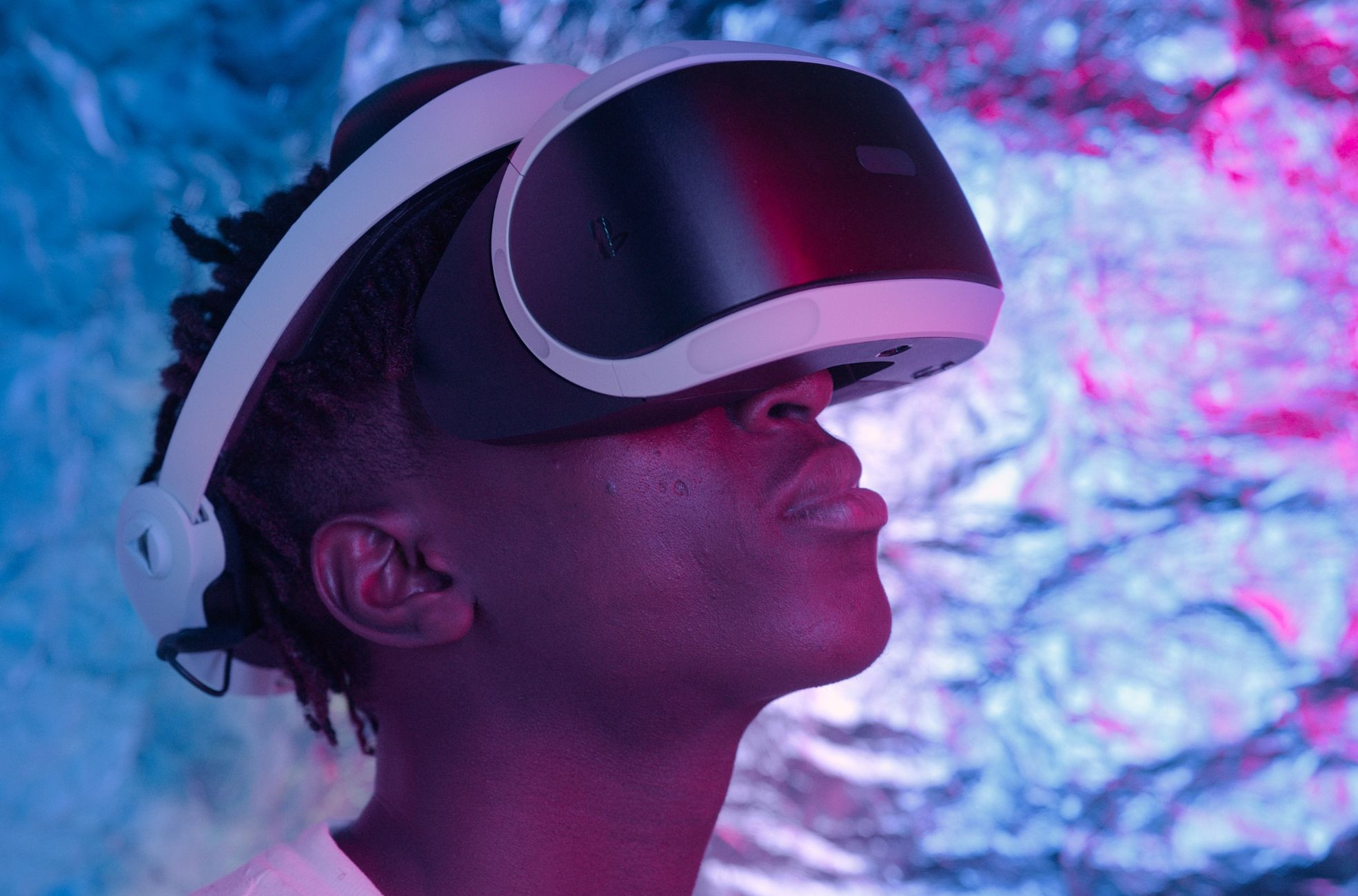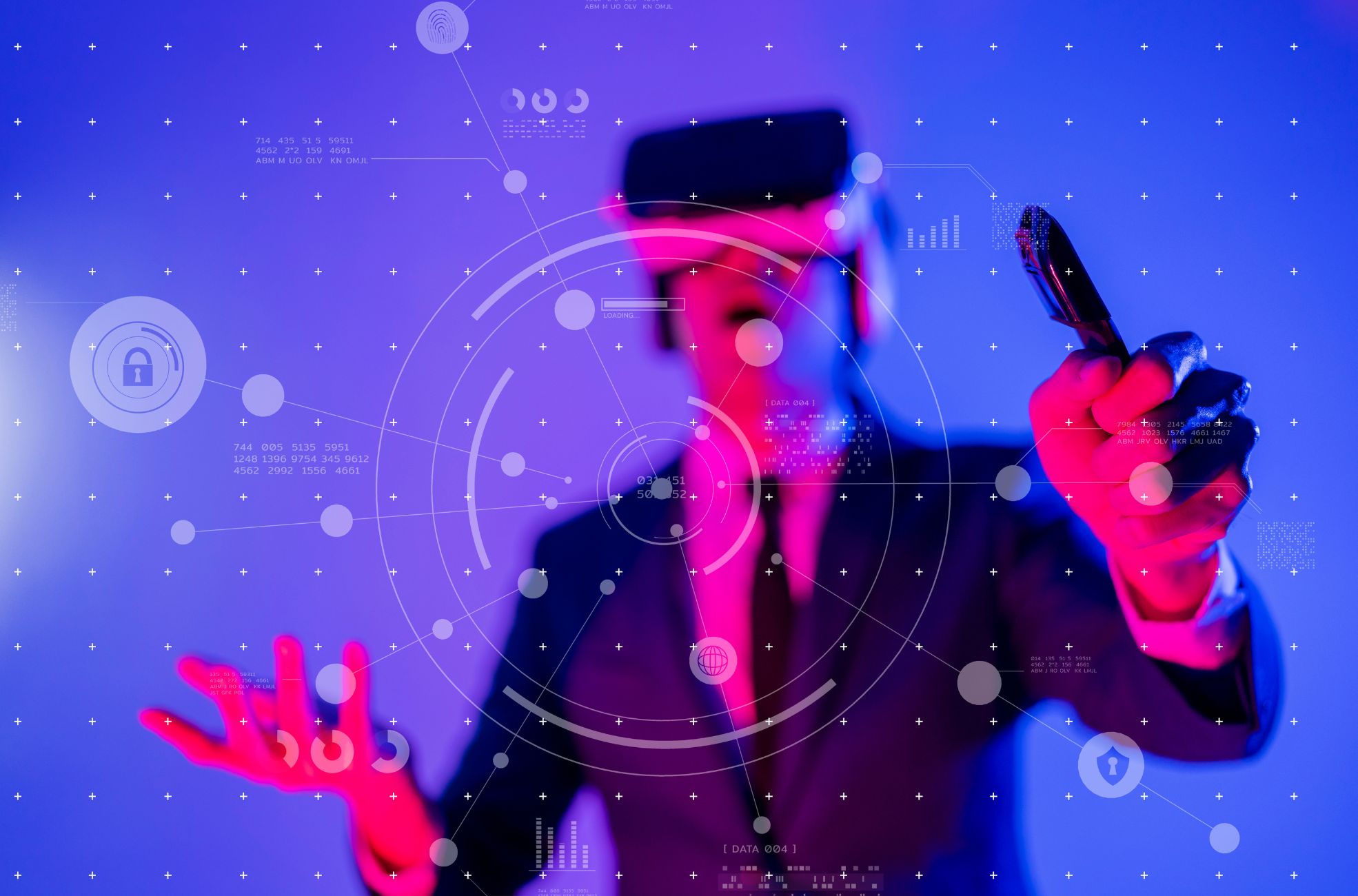Imagine if tech could merge your physical surroundings with digital content, making you feel completely enveloped in mixed reality. That’s what immersive technologies are all about. They’re a blend of Virtual Reality (VR), Augmented Reality (AR), and Mixed Reality (MR). They’re enhancing healthcare procedures, transforming educational methods, and reshaping businesses’ operations.
This article will show how businesses gain from incorporating these technologies into their daily operations, from practical training modules to innovative customer engagement strategies. Want to revolutionise your business operations with these cutting-edge technologies? By the end of this comprehensive guide, you’ll see the immense potential of immersive technologies, their solutions and how they can redefine your business landscape. Let’s get started!
Understanding Immersive Technologies
What Are Immersive Technologies
Immersive technologies blend digital content with your physical environment. This combination creates an immersive experience that lets you interact naturally within a mixed reality. This tech spectrum includes Virtual Reality (VR), Augmented Reality (AR), and Mixed Reality (MR).
VR swaps your physical surroundings with a digital environment. AR adds digital content to a live stream of your physical environment. MR enables interaction between virtual content and the real world.
Brief History of Immersive Technologies
The journey of immersive technologies began with Sensorama. This was a cinematic experience that immersed the viewer into a sensory theatre. The first VR head-mounted display, The Sword of Damocles, was connected to a computer, not a camera.
AR’s development took a significant leap with the creation of Virtual Fixtures. This was the first fully-immersive AR system designed for the U.S. Air Force. Facebook’s acquisition of Oculus for $2 billion (USD) in 2014 highlighted the market interest in VR. The mass appeal of AR was shown by the success of Pokémon GO, which had over 500 million downloads by the end of 2016.
Key Elements of Immersive Technologies
AR uses processors, a display, sensors, and input devices to create an experience. There are four types of AR: Marker-based AR, Markerless AR, Projection-based AR, and Superimposition. AR works best when it enhances your real-world surroundings without needing extra hardware.
On the other hand, VR uses head-mounted displays and input devices to provide a sense of immersion. There are different types of VR for various use cases: Non-immersive VR, Semi-immersive VR, and Fully-immersive VR. VR is perfect for fully immersive, controlled simulations.
The Importance and Benefits of Immersive Technologies
Immersive technologies have entered diverse sectors, including healthcare, education, and business. Surgeons use AR headsets to visualise incisions and access patient information during operations. AR technology helps students visualise text and interactive elements in lectures, boosting knowledge attainment and retention.
Businesses use VR for worker training, sparking creativity in product design, and collaborating with coworkers in different offices. The benefits of immersive technologies are numerous. They lower risk, reduce training time, increase contextualisation, save costs, stir emotional responses, and enhance memory retention.
For instance, Walmart’s VR training module cut training time from 8 hours to 15 minutes. The most significant cost-saving is reduced employee time spent training, practising, and making mistakes.
Immersive technologies also give businesses a unique way to engage with customers. They can stir an emotional response, provide a ‘try before you buy’ experience, speed up product development, and even create new revenue streams. Incorporating immersive tech into your daily work routines can boost productivity and make workplaces safer.
Types of Immersive Technologies
The virtuality continuum, which spans from a purely physical environment to a completely digital one, is the foundation of immersive technologies.
Virtual Reality (VR)
The roots of VR can be traced back to the 1830s with the invention of the stereoscope. This device created a 3D effect by using slightly different images for each eye. It was a precursor to modern VR headsets. By the mid-90s, VR was being incorporated into manufacturing processes.
Augmented Reality (AR)
AR has been adopted in various sectors beyond healthcare and education, which were previously mentioned.
Mixed Reality (MR)
MR, a blend of VR and AR, has found its place in the defence sector for soldier training and battlefield operations.
360° Video
360° video, another form of immersive technology, provides a fully immersive viewing experience, allowing viewers to look in any direction. This technology has been leveraged in marketing, enabling brands to uniquely differentiate themselves and connect with customers. Despite a decline in investment in immersive technologies due to factors such as slow adoption and a lack of consumer demand, experts believe that the introduction of 5G will bring a new wave for these emerging technologies.
By 2025, it’s predicted that immersive technologies could be as ubiquitous as mobile devices. They offer significant benefits, including streamlined product development, quicker market entry, and improved training processes. For its training solutions, for example, Walmart used VR to train over a million associates, significantly reducing training time.
Immersive Technology in Different Industries
Immersive technology is not just about viewing content on screens anymore; it’s about you becoming part of the experience. This is how immersive technology includes VR, AR, MR, 360 video, haptics, and gamification. It’s creating a new reality continuum, transitioning from the purely physical to the entirely digital.
Immersive Tech in Entertainment
The entertainment industry’s been at the forefront of adopting immersive technology. The journey started in the 1830s with the invention of the stereoscope, a forerunner to modern VR headsets. Since then, the industry’s made significant strides in innovation.
Milestones in immersive tech today include creating the first AR machine, The Sword of Damocles, in the 1960s. The launch of Oculus Rift in 2014 was another significant step. Today, immersive technology in entertainment isn’t just about gaming. It’s about crafting unique, interactive experiences that engage you in unprecedented ways.
Application in Education
Immersive technology is reshaping education by making learning more interactive and engaging. You can now interact with objects within a 3D environment. This makes learning more practical and effective.
For instance, medical students can watch live-streamed 3D surgeries from anywhere. This ‘learning by doing’ approach has increased knowledge retention by up to 75%. It also reduces training time by 25%.
Healthcare and Immersive Technology
The healthcare sector is reaping the benefits of immersive technology. It’s being used for therapy, surgical preparation, and even in the whole training process of medical professionals. Interactive 3D modelling tools are being used for product testing before production. This makes the process more efficient and cost-effective.
The advantages of immersive technology in healthcare are numerous. They include risk reduction, reduced training time, increased contextualisation, and improved memory retention.
Future of eCommerce with Immersive Tech
Immersive technology poised to revolutionise the eCommerce industry. Companies are using this technology to enhance your shopping experiences. They allow you to ‘try before you buy’ and visualise products in your homes before purchasing.
This improves the shopping experience and helps brands connect with you in new and exciting ways. The future of eCommerce with immersive technology looks promising. It has the potential to transform how we shop and interact with products.
The adoption of immersive technology does come with its challenges. These include bulky headsets and technical glitches. However, introducing 5G is expected to spur a new wave of immersive technologies. It’s predicted to make them as ubiquitous as mobile devices by 2025.
The market for immersive technology is growing significantly. Its value was estimated at USD 81.82 billion in 2020. The future of immersive technology’s only limited by our imagination. It can transform how we perceive and interact with the world, enhancing our personal and professional lives.
Innovative Use Cases of Immersive Technologies
Immersive technologies are transforming various sectors mining industry, creating unique and engaging experiences.
Virtual Tours for Real Estate
In the real estate sector, these technologies and extended reality are changing how properties are showcased. Virtual tours of properties can now be taken from the comfort of your home, providing a more realistic view of the property than traditional photographs. AR further enhances this experience by allowing you to visualise how your furniture and appliances would look on the property.
Immersive Gaming Experiences
The gaming industry has been quick to adopt these technologies. AR games like Pokémon GO have reached a broad audience, offering a more engaging and interactive gaming experience. VR gaming amplifies player participation by immersing them in a wholly digital environment, making the gaming experience more lifelike.
Training with VR in Industries
These technologies are proving highly effective for training and learning in various sectors. Companies are using VR to train workers in a safe and controlled environment, reducing the risk and cost of training while boosting knowledge retention. In the medical field, students can carry out simulated surgeries, gaining valuable hands-on experience without the associated risks. The defence industry is also using VR to have equipment manufacturers train soldiers in environments that replicate real-world encounters.
Data Visualisation with AR
Data visualisation is another area where these technologies are making a big difference. AR can superimpose digital content on a live stream of the physical environment, providing a more interactive and engaging way to view and understand data. This is particularly useful in fields like manufacturing, where designers can use interactive 3D modelling tools to view and test their products before production starts.
Despite these technologies’ many benefits and increasing adoption, they’re challenging. Issues like bulky headsets and technical glitches can disrupt the user experience. However, with ongoing advancements and the potential introduction of 5G, these technologies are expected to become as common as mobile devices by 2025.
Future Trends in Immersive Technologies
As we look ahead, it’s evident that immersive technologies are poised to become an integral part of our daily lives. Their increasing accessibility and affordability are making them more appealing to a broader audience across various sectors.

Increased Accessibility and Affordability
The ease of use and decreasing costs drive immersive technologies’ popularity. While there are still hurdles to overcome, such as the size of some devices and occasional technical issues, the advent of 5G is set to usher in a new era for these technologies. Enhanced download speeds and reduced latency will facilitate on-the-go access and interaction with virtual content, potentially making these technologies as prevalent as smartphones in the near future.
Combining AI with Immersive Technologies
Integrating Artificial Intelligence (AI) with immersive technologies is another promising development. This fusion can generate even more interactive experiences, enhancing the sense of being part of the virtual environment. AI can facilitate the creation of dynamic content that reacts to user actions in real time, leading to a more engaging and personalised experience.
Development in Haptic Technology for VR
Advancements in haptic technology, which provides tactile feedback to the user, is another noteworthy trend in VR. This technology can make virtual experiences feel more tangible, allowing users to touch and interact with virtual objects as if they were physical. This significantly enhances the sense of immersion, making VR experiences more compelling.
Growth and Adoption in Massive Industries
Immersive technologies are finding applications in various sectors, including education, healthcare, manufacturing, and defence. For instance, in education, these technologies can facilitate the creation of interactive 3D environments, enabling students to explore and interact with objects in ways that wouldn’t be possible in the real world.
In the corporate sphere, immersive technologies can revolutionise business operations. They can streamline processes, create safer and more productive workplaces, and enhance customer experiences. They also have the potential to generate new revenue streams, such as virtual real estate, and open up new opportunities for experiential marketing.
Harnessing the Potential of Immersive Technologies
As we’ve explored, immersive technologies are no longer a futuristic concept. They’re here and rapidly becoming part of our daily lives. From entertainment to education, healthcare to eCommerce, these cutting-edge immersive technologies deliver and are reshaping how we interact with the world.
The hurdles standing in the way are being swiftly addressed as faster network speeds, affordable devices, and integration with AI become a reality. Despite the challenges, the immense potential for immersive technologies is evident. As businesses, we need to harness their power to enhance our operations, engage our customers innovatively, and stay ahead of the curve in this fast-paced digital age.











